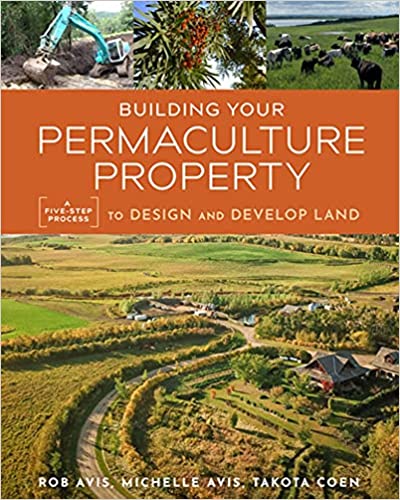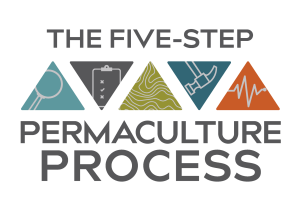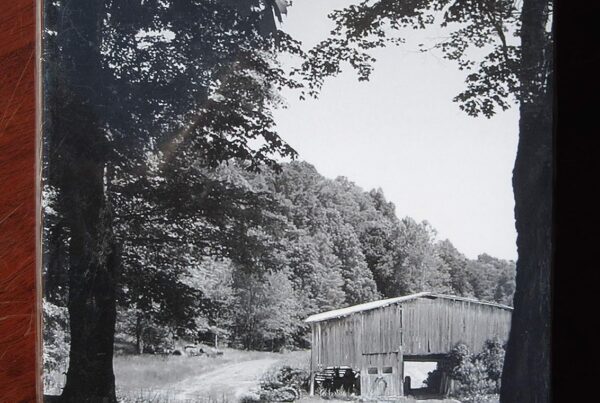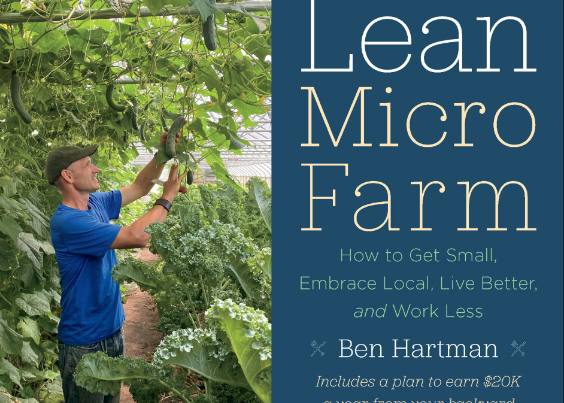
Thank goodness for this book! I had already admired some of the work of Michelle and Rob Avis in Adaptive Habitat (ecological design and sustainable technology), so I knew them to be committed and practical. I am one of those put off from permaculture by the worshipful jargon of some followers, and the peculiarly male-dominated field. This book restores my faith in being able to benefit from and use the good ideas in permaculture without abandoning independent thought or the all-important holistic approach.
This book is a valuable and realistic resource from authors who have “earned their share of cuts and bruises”; a guide to clarifying your goals, attitudes and approaches to holistic land management; a step-by-step guide to get from today to a future aligned with your dreams.
This is not an introduction to permaculture, or a quick-fix for your garden, woodlot, home energy source, flooded land, compacted soil, or back aching from rototilling! There is a common misperception that permaculture is about a set of trendy vegetable gardening techniques. Here is a careful Five Step Permaculture Process, with exercises, templates, workflow tools and thoughtful questions. It addresses real challenges.
The book is introduced by the quote from Bill Mollison (one of the cofounders of Permaculture), defining Permaculture: “Permaculture is the conscious design and maintenance of agriculturally productive ecosystems which have the diversity, stability and resilience of natural ecosystems. It is the harmonious integration of landscape and people providing their food, energy, shelter, and other material and non-material needs in a sustainable way.”
When Rob and Michelle were teaching, Rob was often ashamed to mention the word “permaculture”. Despite the elegant practical solutions for solving systemic problems with food, water, housing and energy systems offered by Bill Mollison and David Holmgren in Permaculture One, most people publicizing permaculture talk about zones, guilds, keyhole and spiral planting beds. “Putting a herb spiral in your backyard while you still source the majority of your basic needs from the degenerative food, water and energy systems is simply permaculture tourism.” Thank you! Straightening the deckchairs on the Titanic! Society’s big messes will not be helped by a herb spiral!
The authors believe that the root cause of people becoming disenchanted in permaculture is a lack of a clearly defined process. They ask the question “What is the biggest problem you are struggling with right now putting permaculture into practice?” and have found that answers fall into five categories.
- I don’t know what I should do. (Unclear goals.)
- I don’t know where to look. (Inadequate information.)
- I don’t know how it all fits. (Confusion.)
- I don’t know where to start or what’s next. (Being overwhelmed.)
- I don’t know when it will end. (Burnout)
All indicate a lack of something important. The authors decided that instead of teaching students what to do, they would teach them how to solve their problems. We benefit from focusing less on specific practices (those herb spirals!) and more on making a clear step-by-step process for how to design, develop, and manage a property to provide all the food, water, shelter and energy needs in harmony with the ecosystem.
In the Five-Step Permaculture Process, each step addresses one of the five Biggest Struggles:
- Clarify vision, values, resources
- Assess strengths, weaknesses, opportunities, threats in your resources
- Design your use of resources to meet vision and values
- Implement the design that most improves your weakest resource
- Monitor for well-being or suffering
 Buy the book, check out their website, I’m not going to spell it all out here! It’s easy to forget that hours of learning and practicing a skill come before becoming an expert! Persistence and process are both needed.
Buy the book, check out their website, I’m not going to spell it all out here! It’s easy to forget that hours of learning and practicing a skill come before becoming an expert! Persistence and process are both needed.
The illustrations from Jarett Sitter throughout the book look like those from children’s picture books, although examination reveals symbols of the permaculture journey. Each chapter includes sidebars with enlightening segments from Takota Coen’s Story developing regenerative agriculture as a fourth generation farmer.
The heart of the book addresses the five steps and the initial foundation (Step 0) to guide you through design and management. Approach the steps in the order given, and be open to the possibility that you will need to tackle several aspects at once. Like learning to play guitar by learning to read music, keeping time, strumming a rhythm and making a chord, you will need to practice many skills and pull them all together as you go. Find an independent Accountability Partner, who is tackling a similar permaculture challenge, but is not invested in the same one as you. You will gain support and motivation.
The foundation chapter (Step 0) is about inspecting our conscious and unconscious beliefs about reality, which determine our vision, our actions and our responses to other people. We look for hindrances such as confirmation biases (remembering information that supports our existing preconceptions); endowment effects (demanding more to give up something than we would pay to acquire it); the IKEA effect (giving higher value to things we have assembled ourselves, regardless of actual quality!)
The authors define two predominant downward spiraling paradigms: ‘degenerative’ and ‘sustainable’, in contrast to the upward spiraling ‘regenerative’ paradigm. The degenerative paradigm cycles through arrogance, extraction, combat and suffering, creating an increasingly fragile system. The ‘sustainable’ paradigm seeks to maintain the status quo, cycling through guilt, conserving, controlling and surviving, creating a resilient system. The ‘regenerative’ system is anti-fragile, getting stronger, cycling up through reverence, co-creation, designing, thriving.
I dislike this definition of “sustainable” – people in survivalist mode, delaying on their own land the effects of societal collapse. As the author of a book with the S word in the title, I feel a bit defensive. I am not the guilt-ridden, masochistic, fearful, self-hating type portrayed. How does this stereotype help the authors make converts? I share with permaculturists feelings of reverence, awe, co-operation, justice, humility, compassion and being part of nature. But I am not a permaculturist. I use the definition of sustainable in the 1987 Brundtland Report: “meeting the needs of the present without compromising the ability of future generations to meet their own needs.” I do agree with the authors that ableness to sustain or maintain is not a guarantee that sustaining will happen.
From the perspective of word meanings, regenerative suggests being able to or tending to regenerate, renew or restore, especially after injury, or damage. It includes the sense that something has gone wrong and we are going to ride in and fix it, returning things to a previous state. Yes, corporations and individuals do co-opt the word sustainable, for industrial agriculture, as happened previously with the words organic, biological, ecological. And will happen with the word regenerative. In a few years, this word too, will be seen as having shortcomings, meaning retro-farming, or something unfortunate like that.
Step 1 is to clarify vision, resources and values. The large number of options can be reduced to those that answer all three questions, What do you want? What resources do you have? and What matches your values? The overlap of the first two filters out the impossible. The permaculture movement has developed helpful tools: the Needs and Yields Analysis, when applied to ourselves, will help answer the first two questions, and the Three Permaculture Ethics of earth care, people care and future care gives guidance on clarifying values.
Make an inventory of your resources, starting with money and material resources, and moving into natural, social, spiritual, experiential, intellectual and cultural resources. Your personal resource inventory should include debts (negative resources) and resources you have access to without ownership. Step 1 also includes thought experiments on increasing wellbeing for all, and the creation of a Vision and Values One-pager. Because most of us want to share our lives with others, we need to resolve interpersonal conflicts, to build shared vision and value statements. The process of writing down your desires in broad daylight helps with inspection and reflection.
The most common design mistakes when clarifying visions and values are focusing on the what rather than the why; using language traps like the future tense which let you off the hook for actually doing anything today; identifying yourself as outside the ecosystem looking in, and being paralyzed by perfection. There are free templates for the exercises on <https:www.mypermacultureproperty.com> and practice tips at the end of the chapter.
Jared Diamond, in Collapse, his study of collapsed societies, notes: “Two types of choices seem to me to have been crucial in tipping the outcomes towards success or failure: long-term planning and willingness to reconsider core values.”
Step 2: Diagnose Your Resources for Strengths, Weaknesses, Opportunities and Threats, opens with encouragement to search out any information that could make or break your plans.
You can organize your property resources into 11 categories: geography, climate, water, access, structures, fencing, flora, fauna, business, technology and soil. There’s another helpful chart. Use a pattern found in nature to gather, store, organize and retrieve your info, based on these categories. This functions to help create an ordered workflow (order of operations) for design and implementation.
Diagnosis has two stages, firstly making observations about your resources using the four variables of patterns (form, timing, placement, scale). There’s a chart about this, with descriptors that fit each mode. Secondly SWOT analysis, where you make value-based judgements about each resource. Strengths and weaknesses are attributes within your project. Opportunities and threats are outside your project but close enough to have an impact. There is a big chart with examples for each of the 11 categories.
Be warned that every property seems to have a hidden piece of information that, if discovered, can change everything for the better. Takota Coen describes discovering he had (at big expense) had a pond dug in the wrong place. He thought he knew the land so well he didn’t need to put his design on paper. After learning to use Google Earth Pro (it’s free!), he discovered a much better pond site. The website has tools to help you make effective use of GIS programs.
Step 3: Design Your Resources to Meet Your Vision and Values. When you draw out a design in detail on paper, you gain insights into how to create it in real life and reduce silly mistakes. There are three misconceptions about what design is. Designs are not fixed in stone – if you become aware of ways to improve your design, you do it! Design is not just aesthetics, but is structural, functional, and also beautiful. The best way to improve something is not always to add to it — many improvements come with removing something, or taking a very different approach.
Regularly ask yourself what you are aiming to achieve, and what other options would also provide the same outcome. Don’t decide you need a swale, or a solar greenhouse until you identify a goal and weigh up the options for reaching the goal, and come out with the answer that best satisfies the goal.
Two useful method of design that can be tweaked for this job are the needs and yields analysis and the sector analysis. Both are carefully explained. They examine if every need of every element is fully met within your system; if every yield is fully used; if every element serves multiple functions; if every function is served by multiple elements; and if all is functioning ethically.
Consider each of the energy sources and sinks on your farm, whether you want that energy and how you will make best use of it if you do want it. There are suggestions of what sources and sinks to consider, as well as ways to reduce losses. There’s an engaging list of tips, including “When you are working, work; when you are chilling, chill. Make it a binary.” Also, reduce clutter, distractions (social media), and set up a ritual for starting deep work on your design. Use your accountability partner. Gather all your worksheets in one place.
Step 4: Implement the Right Design That Will Most Improve Your Weakest Resource, opens with a note that “the dirty little secret of permaculture is that design is the easy part, it is the implementation that kills you.” When one of your resources fails, it will no longer be helping you thrive, it will start to cannibalize the farm. This can happen if you made a poor decision earlier. This chapter helps you organize workflow, make weekly plans, make good decisions, and not rush to get to your goal in what looks like the fastest way.
Problems can arise if you tackle tasks in a poor order. Go back to the 11 categories of resources. Geography comes first, because once chosen, it cannot be changed easily or quickly. The categories that are listed higher impact all those below them. Don’t abandon the list because soil is last! Soil is very important, of course, but there is no value in getting into the detail of the best cover crops, if you have not dealt with water supply and drainage to prevent runoff, or dealt with wind erosion.
Look for weakest links (biggest gaps between vision and resources), turn this gap into a Wildly Important Goal (achievable and exciting), and focus with the formula “from X to Y by when?”. Each week commit to one or more actions that will lead in the right direction, schedule them weekly, and check them off when done. The book has an extensive chart of examples.
Revisit Step 3 (Design) with its description of good, bad and ugly designs, and transfer the descriptions to decisions. What is your process for making good decisions? Many people are not consciously aware of how they make decisions. Intuition alone is not enough. Use the Good Decision Worksheet.
After writing down your decision, check its alignment with your values; any possibly ruinous outcome; whether it actually addresses the problem; whether it’s your best use of your resources; the risk/reward ratio; then sleep on it and repeat the process; pass the idea by your accountability partner; flip a coin to check if your emotions align with your decision; write down what needs to be done, and early indications of whether you have made the best decision.
Step 5: Monitor Your Resources for Indicators of Well-being or Suffering. You can only manage what you measure (but you can measure more things than you can manage!) Precision is not the same as accuracy! Knowing exactly how many beetles are on your plants does not provide the whole answer on what to do. Rather than focus entirely on numbers, monitor for suffering and well-being. “The one thing never found in a healthy ecosystem is excessive suffering.” There will always be some suffering – it is feedback on the situation and the design that led to it. Determine what actions you can take to improve things.
There are two categories of resources, personal resources and the 11 categories of property resources. Look at your Vision and Values Sheet and use your Indicators of early signs of success or failure to see if you are heading towards well-being or suffering. Takota tells the story of figuring out when and why his cows got mastitis, and making a small change he had resisted, increasing well-being, and preventing mastitis from then on.
Increase awareness of your own state of being: if you feel patient, grateful, relaxed and enthusiastic, you are in a state of well-being. If you are sleepy, angry, resentful, jealous and prone to procrastination, you are suffering. Do you hum as you work, or curse? Your coworkers will know your signs of distress, if you can’t tell for yourself.
Keeping a journal can help monitor your well-being. Write down the answers to 3 questions in the morning. What are you most excited about today? What are you most grateful for? What is one thing you could do to make today great? In the evening, ask: What is the most amazing thing that happened today? What could I have done better? What was my biggest insight today?
At the end of each month, review your weekly planner sheets, and your daily reflections. Answer questions on a range of 0-10, and compare your answers the previous month. How clear are you on what your weakest link is? How confident are you that what you are doing is addressing this weakest link and moving you towards your goal? Have you seen signs that you are increasing well-being (or suffering)? What has been this month’s most valuable insight?
Monitor your 11 property resources yearly, looking for signs of increased well-being. There is a template! Shockingly, cropland globally is often bare for 30-50% of the year, wasting the potential photosynthesis, and degrading the soil. Soil carbon can (on average) hold four times its weight in water. Another source of potential wastage or potential improvement. When the solar cycle, the water cycle and the soil nutrient cycle interact well, the flora and fauna spiral towards the climax ecosystem for that region.
Monitor, reflect, record, compare results with your vision and values statement, monitor your ecosystems. Make a paper planner and use it for a full year before reviewing. There are templates and suggestions for designing your own planner.
A lot of the ideas in this book make a great deal of sense even for those of us who don’t identify as permaculturists! Careful design and planning, checklists, worksheets – these can save all of us wasted effort or heartache. This thoughtful book can be useful to every farmer or landowner. As I’ve often noted, any gardener or farmer paying close attention and recording their results, has something valuable to teach us, whatever they call the style of their farming.
Book Review: Building Your Permaculture Property, A Five Step Process to Design and Develop Land, by Rob Avis, Michelle Avis and Takota Coen.
New Society Publishers, 2021, 222 pages, $49.99, color photos and illustrations throughout.
BOOK REVIEW BY PAM DAWLING






